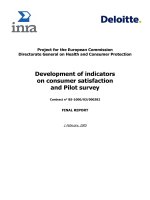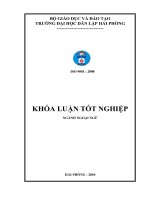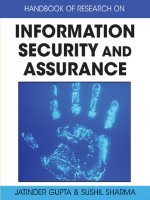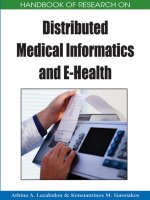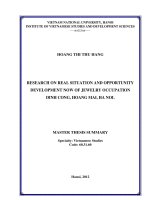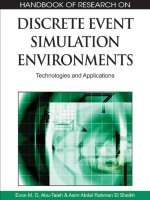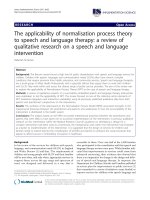hanbook of research on k12 online and blended learning
Bạn đang xem bản rút gọn của tài liệu. Xem và tải ngay bản đầy đủ của tài liệu tại đây (11.55 MB, 541 trang )
Handbook of Research
on
K-12 Online
and
Blended Learning
Handbook of Research on K-12 Online and Blended Learning
Copyright © by
Richard E. Ferdig and Kathryn Kennedy
and ETC Press 2014
Design Direction by Shirley Yee
ISBN: 978-1-312-58708-3
Library of Congress Control Number: 2014953854
TEXT: The text of this work is licensed under a Creative Commons
Attribution-NonCommercial-NonDerivative 2.5 License
( />
IMAGES: All images appearing in this work are property
of the respective copyright owners,
and are not released into the Creative Commons.
The respective owners reserve all rights.
For those who “learn to devote themselves to doing what is good,
in order that they may provide for daily necessities and not live unproductive lives”
(Titus 3:14, NIV)
V
PREFACE
Introduction
We were sitting in a hotel lobby in New Orleans at a technology and education conference.
We both had been working in the field of K-12 online and blended learning for some years.
Our coffee conversation focused mainly on the progress of research that had been published
in the area since the inception of K-12 online education in the mid 1990’s. We shared both
our optimism for the continued research in the field as well as our relative frustration at a lack
of awareness of that research. Although most of the people doing work in the area knew each
other (and even occasionally worked together), many new to the field thought that they were
discovering K-12 online and blended instruction for the first time.
This wasn’t an egotistical exercise; this wasn’t another occasion where one academic was calling
out peers for not including their citation or reference in a paper. Rather, this was a problem
as researchers—particularly those new to the field—seemed to be lacking the opportunity to
proverbially ‘stand on the shoulders of giants.’
There is no clear reason why this happens. Perhaps it has to do with the fact that people in
the field publish in a wide variety of journals. Articles in K-12 online and blended instruction
might appear in anything from the Journal of Technology and Teacher Education to The International Review of Research in Open and Distance Learning and from the Journal of Medical
Internet Research to The Internet and Higher Education.
To be honest, we were less concerned about why this happened and more interested in how
to fix it. We recognized we needed one location to catalog—and more importantly to synthesize—the existing research in the field. And so in that hotel lobby in New Orleans, the idea
for this handbook was born. We decided we wanted to create a handbook that would act as a
key resource for existing and new researchers, practitioners, and policymakers in the field. We
later shared the idea with fellow researchers who reciprocated their interest. We then had the
blessing of beginning a conversation with Drew Davidson from Carnegie Mellon.
Drew is a professor at CMU as well as the founding editor of ETC Press. ETC Press is interested in the participatory nature of publishing. As such, they publish texts that are available
electronically and openly with Creative Commons licenses. Readers can choose to download
the materials, thus making them more widely available. Or, they can also pay to have a print
VII
version sent to them from Lulu.com.
What we enjoyed about working with Drew, Shirley Yee, and the rest of the ETC Press team
is that they pushed us to think more deeply about the book. For instance, was this handbook
going to be full of op-ed articles? Was this going to be a catalog of existing research for that
year? How would we ensure that it was representative of research in the field? The fact that we
were asked these questions early in the process—as well as the fact that we were publishing a
book about electronic technologies in an electronic format—helped us strengthen the quality
and accessibility of this book.
What this book is…and what it is not
This handbook is meant to be a resource for anyone interested in research, practice, or policy
in the field of K-12 online and blended learning. This book is not intended to be a collection
of opinions on the field. Nor is it meant to be a compendium of the top research articles for
this past year. It is not a list of what is currently trending in K-12 online and blended schools.
And, it is not a list of ‘best pieces’ from leading researchers in the field. Rather, this handbook
is a collection of what we currently know about research in the field.
There are at least three main goals for completing this work:
1. To continue to strengthen our field by providing clear evidence of what is known
and what is yet to be known;
2. To provide an empirical resource for researchers (new and experienced) as well as
parents, media, administrators, and policy officials; and
3. To set in motion a yearly close examination of our field.
The Book’s Outline
Our first step in creating the layout for this handbook was to discern the major topics in
the field. There were three key ways we addressed this task. First, we examined the existing
research in the field. We used that research to create categories. If we found an article that did
not fit within a category or one that challenged our existing structure, we revised our framework. We continued with that process until we felt like we could comfortably fit existing
research articles into the broad headings.
VIII
The second step was to compare that framework with existing handbooks of research. Obviously K-12 online and blended learning is a unique research area. However, other handbooks—particularly those in education—contain frameworks that are useful in helping to
frame our work. We used those handbooks to determine areas of overlap as well as components that were missing from our framework.
The final step was to talk to experts in the field. We shared our framework with researchers
and practitioners in the field. We asked them to evaluate the framework to see what we had
gotten right and what we were missing. The outcome of the entire process was a six-section
framework that included the following broad headings:
I. A Background and Historical Perspective – What are the important background
and historical markers that help contextualize research in K-12 online and blended
environments?
II. Research on Learning and Learners – What does the research say about learning
in K-12 online and blended environments?
III. K-12 Learning in the Content Domains – What does the research say about
similarities and differences within content areas?
IV. Research on Teaching – What does the research say about preparing and mentoring
current and future teachers?
V.
Research on the Role of the Other – What does the research say about the role
of the preparing and mentoring others who support K-12 online and blended
environments?
VI. Research on Technological Innovations – What does the research suggest might
be new and innovative technologies that will transform how we conduct and think
about teaching and learning in K-12 online and blended learning?
IX
The General Outline of Chapters
After creating the framework, we contacted researchers in the field to ask them to consider
writing under each of the broad topics. We made suggestions as to when and where the
authors’ work might fit; however, we left it up to the authors to choose topics they felt most
comfortable with. We asked authors in the “Background and Historical Perspective” to help
set the stage for a deeper understanding of the research by providing a background and contextual information about K-12 online and blended instruction. We suggested to the authors that
after consuming the chapters in this first section, the reader should have a context by which to
understand the specific areas of research in the other sections in the book. This would include
an introduction, a discussion, and then a conclusion that set the stage for both where we are
now and understanding what might come next.
Authors for the remaining five sections received more explicit instructions as we wanted consistency between chapters. We asked authors to ensure that each chapter would include:
• Introduction – explain purpose and objectives of chapter. Include a layperson’s
description of the topic in a short overview including relevant definitions.
• Research Synthesis – categorize and present the research, preferably in themes,
such that the chapter does not become a laundry list of everything published in
that area but rather a synthesis of what we understand.
• Implications for Policy and Practice – given the research synthesis, what are the
direct implications for policy, instruction, and preparation of teachers, students,
and administrators?
• Implications for Research – given the research synthesis, this section sets the stage
for what we have yet to learn that is a research gap in this specific context.
• Conclusion – What are the top highlights in terms of what we know about research, policy, and practice, and where we need to go next?
• References – this should be a section that highlights further reading as presented
in the article.
X
Conclusion and Next Steps for Readers
The purpose of this handbook is to present a compendium of research devoted to K-12 online
and blended learning. The goal is that any researcher or practitioner would be able to return
to this Handbook and seek relevant and current information. There is value in having clearinghouses that attempt a similar purpose by linking to all the existing evidence (e.g. http://
k12onlineresearch.org/). The value of this exercise is to move beyond collecting the research
to also providing syntheses of those studies. The goal is to offer an understanding of where we
have been and what research still needs to be conducted.
In order to continue to be relevant, our goal is to reproduce this Handbook each year, updating chapters to reflect current research. Readers will undoubtedly see gaps in the chapters
and in the topics that are present—or missing—in this book. In some cases, these gaps were
related to researchers who weren’t able to contribute to this iteration of the book. In other
instances, gaps in chapters or missing topics in the book were related to a lack of literature in
the field.
It is worth noting that we attempted to collect chapters even if there was limited research in
the field. We wanted existing and new researchers and practitioners to see where we had gaps.
We often had conversations with authors where we told them that it was ok to have a short
research synthesis section of their chapter. We encouraged them to focus instead on what we
knew outside of the literature to point to promising new areas of research and practice. Thus,
in one year a chapter might have a small research synthesis section and a large section on research needs. A few years later and the ratio of text may have drastically flipped.
In conclusion, we ask readers to think of this work not as a completed product but rather a
flowing conversation. We have attempted to get authors to note areas for future research.
And, we ourselves have pointed at chapters we would like to have in future iterations. We
encourage authors to contact us at to propose missing research
studies for certain chapters or for proposals on new chapters for future iterations.
XI
We are so pleased to be able to present this iteration of the Handbook of Research on K-12 Online and Blended Learning. We believe the authors have contributed thoughtful and thorough
syntheses of existing literature. Researchers, practitioners, and policymakers will find useful
evidence as well as next steps for conducting studies or improving practice. Our authors have
written such thoughtful and well-written pieces that people will read this book and be
able to help further understand not if K-12 online and blended learning works, but when,
how, and under what circumstances. We invite you, the reader, to join the conversation.
Respectfully,
Richard E. Ferdig, Research Center for Educational Technology, Kent State University
Kathryn Kennedy, MVU, Michigan Virtual Learning Research Institute
September 1, 2014
XII
Acknowledgements
An edited book would not be possible without the contributions of authors. We would like
to thank our authors for their hard work and dedication to the book. We would also like to
thank Drew Davidson, Shirley Yee, and the review board from ETC Press (Carnegie Mellon)
for taking on this project. Drew brought a wealth of experience in publishing open-source
content. He was always quick to respond to a phone call or email and guided us through this
process. We appreciate Drew’s attention to the details surrounding the publishing of this book.
We also enjoyed meeting and getting to work with Shirley who worked closely with us during
the submission and publication process.
In closing, we wish to thank our families for their support of our professional efforts, allowing
us to give up personal time to complete this task.
XIII
Handbook
of Research
on K-12 Online and Blended Learning
Edited by
Richard E. Ferdig
&
Kathryn Kennedy
I. A Background and Historical Perspective
1. A History of K-12 Online and Blended Instruction in the United States
John Watson & Amy Murin . . . . . . . . . . . . . . . . . . . . . . . . . . . . . . . . . . . . . . . . . 1
2. History of K-12 Online and Blended Instruction Worldwide
Michael K. Barbour . . . . . . . . . . . . . . . . . . . . . . . . . . . . . . . . . . . . . . . . . . . . . 25
3. Research and History of Policies in K-12 Online and Blended Learning
Kerry Rice . . . . . . . . . . . . . . . . . . . . . . . . . . . . . . . . . . . . . . . . . . . . . . . . . . . . . . 51
4. A Brief Look at the Methodologies Used in the Research on
Online Teaching and Learning
Susan Lowes . . . . . . . . . . . . . . . . . . . . . . . . . . . . . . . . . . . . . . . . . . . . . . . . . . . . 83
II. Research on Learning and Learners
5. Research on At-Risk Learners in K-12 Online Learning
Jeanne B. Repetto & Carrie J. Spitler . . . . . . . . . . . . . . . . . . . . . . . . . . . . . . . . 107
6. Reviewing a Decade (2004-2014) of Published, Peer-Reviewed Research
on Online Learning and Students with Disabilities
Diana Greer, Mary Rice, & Bryan Dykman . . . . . . . . . . . . . . . . . . . . . . . . . . . 135
III. K-12 Learning in Content Domains
7. Few in Number: Research on Mathematical Teaching and Learning in the
Online Setting
Karl W. Kosko, Lauren Sobolewski-McMahon, & Md Amiruzzaman . . . . . . . . .163
8. Research on Literacy Instruction and Learning in Virtual, Blended, and
Hybrid Environments
Kristine E. Pytash & W. Ian O’Byrne, . . . . . . . . . . . . . . . . . . . . . . . . . . . . . . . 179
9. Research on Teaching Blended and Online Physical Education
David N. Daum & Craig Buschner, . . . . . . . . . . . . . . . . . . . . . . . . . . . . . . . . . 201
IV. Research on Teaching
10. Teacher Preparation for K-12 Online and Blended Learning
Leanna Archambault & Kathryn Kennedy . . . . . . . . . . . . . . . . . . . . . . . . . . . 225
11. Professional Development for K-12 Online Teachers
Kara Dawson & Nancy Fichtman Dana . . . . . . . . . . . . . . . . . . . . . . . . . . . . . 245
12. Mentoring for Online Teachers
Kara Dawson & Nancy Fichtman Dana . . . . . . . . . . . . . . . . . . . . . . . . . . . . . 267
V. Research on the Role of the Other
13. School Administrators and K-12 Online and Blended Learning
Scott McLeod & Jayson W. Richardson . . . . . . . . . . . . . . . . . . . . . . . . . . . . . . . 285
14. Parental Involvement in K-12 Online and Blended Learning
Lisa Hasler Waters, Michael P. Menchaca, & Jered Borup . . . . . . . . . . . . . . . . . 303
15. On-site and Online Facilitators: Current and Future Direction for Research
Jered Borup & Jeff S. Drysdale . . . . . . . . . . . . . . . . . . . . . . . . . . . . . . . . . . . . 325
16. The Role of the School Psychologist in K-12 Online & Blended Learning
P. Dawn Tysinger, Jeffrey A. Tysinger, & Terry Diamanduros . . . . . . . . . . . . . . 347
17. K-12 Online and Blended Learning, School Libraries, and School Librarians
Brenda Boyer & Rebecca Kelly . . . . . . . . . . . . . . . . . . . . . . . . . . . . . . . . . . . . 365
VI. Research on Technological Innovations
18. K-12 Mobile Learning
Cathy Cavanaugh, Dorit Maor, & Aidan McCarthy . . . . . . . . . . . . . . . . . . . . 391
19. Open Learning in K-12 Online and Blended Learning Environments
Lee Graham, Randy LaBonte, Verena Roberts,
Ian O’Byrne, & Colin Osterhout . . . . . . . . . . . . . . . . . . . . . . . . . . . . . . . . . . 415
20. Personal Learning Environments in K-12
Wendy Drexler. . . . . . . . . . . . . . . . . . . . . . . . . . . . . . . . . . . . . . .. . . . . . . . . . 447
I.
A Background
and Historical Perspective
What’s this section about? The main goal of this book is to provide a summary of the existing research related to K-12 online and blended learning. Readers will have the opportunity to
more fully explore significant topics in both breadth and depth. And, in doing so, the reader
will more fully understand what we knew, what we know, and what we have yet to learn.
Prior to that exploration, it is important to set the stage for understanding that research.
When did K-12 online and blended instruction begin? Do the advancements in the United
States mirror international contexts? What is the past, current, and future relationship between research, policy, and practice? Are there specific research methods that have been used
or have proven successful in K-12 online and blended research? The four chapters in this
section set the stage for this entire book by asking and answering those important questions
and more.
What’s in this section? Watson and Murin convey the simple nature of K-12 online learning
when it first began and admit that today the “landscape is much more complex.” They emphasize that research says K-12 online learning can work, however, various implementation factors
need to be taken into account for programs’ potential to come to fruition.
Barbour’s chapter sheds light on what is happening internationally in regard to K-12 online
and blended learning. Barbour discusses how government funding is the impetus for change,
varying terms are used to describe online and blended learning, use of legacy delivery models,
and the prevalence of secondary implementation over any other grade level.
Rice shares a comprehensive overview of U.S. education policy where she illustrates a tendency
for political maneuvering and fragmented implementations. She suggests a shift in culture
surrounding education and learning to move towards transparency and accountability, where
students’ learning is fostered, teachers’ and administrators’ contributions are heard, and innovation and risk-taking are front and center. This shift would help policy to reform in a way
that is conducive to the learning environments that are here today and those that will be here
tomorrow.
Lowes advocates for mixed methods research to ensure a full picture of K-12 online and
blended learning environments, examining from both the narrow and the broad. She also sees
research in this area open for burgeoning methodologies that may build on existing ones and
take into account the various nuances apparent in our field.
What’s missing from this section? Future iterations of this book will provide chapters that
continue to lay a framework for research in K-12 online and blended instruction. There are
opportunities for new authors to add to this Handbook by writing about critical background
and historical information such as: program evaluations, deepening definitions in the field,
cultural perspectives, asking the right questions about K-12 online and blended instruction,
understanding diversity, appreciating changes in school culture, and explorations of the relationships between blended, virtual, and traditional schools.
Chapter 1
A History of K-12 Online and Blended Instruction
in the United States
John Watson, Evergreen Education Group,
Amy Murin, Evergreen Education Group
Abstract
This chapter will cover the history and progression of online and blended learning in K-12
education in the United States. Program categories covered include state virtual schools, fully
online schools, and blended learning. Key policy issues affecting the development of online
and blended learning are also addressed, including online learning requirements, student
achievement, and funding.
Introduction
Many of the early adopters in K-12 online learning were programs that evolved from correspondence schools or distance education programs (Watson, 2012). This includes, for example,
the North Dakota Center for Distance Education, which began offering correspondence classes
in 1935 and evolved to offer classes through many different delivery methods, including online
learning. The University of Nebraska High School began delivering paper-based correspondence courses in 1929, launched its first “Tele Learning courses” where students submitted
work by email in 1985, and offered its first full diploma sequence online in 2001.
Other programs launched in the 1990s and early 2000s in an effort to offer online courses in
order to expand course catalogs, better serve students who need to recover credit, and serve
undercredited and overage students, including the programs below.
• The Virtual High School (VHS) is a nonprofit collaborative of schools founded in
1
1995 that began offering online classes in fall 1997. It has over 700 partner schools
in 40 states, as well as 35 international schools. VHS has expanded its offerings
over the years to include private and custom courses, blended learning support,
and online professional development to help educators develop the skills they need
to teach online and integrate technology into their classrooms. (Retrieved July 18,
2014 from />• Florida Virtual School (FLVS) began as the “Web School” in Orange County,
Florida, during the 1996 school year. Encouraged by the Florida Department
of Education (DOE), it then partnered with Alachua County and received a
$200,000 grant from the DOE in November 1996 intended to develop the Florida
High School (FHS) project. FHS officially launched with seven staff members in
August of 1997. Following the original grant, FLVS operated from a recurring lineitem in Florida’s legislative budget until school year 2003-04, when FLVS became
fully funded as a statewide virtual school and became part of the Florida Education
Finance Program (FEFP). From the $200,000 grant in 1996, FLVS continued
to grow and became a statewide school district, serving both full-time and parttime students. FLVS is affiliated with all 67 Florida school districts; it served over
400,000 supplemental course enrollments and 5,300 full-time students in school
year 2012-13 (Florida Virtual School, 2013).
• The DIAL Virtual School is an initiative of the Dakota Interactive Academic Link
consortium and began offering distance classes in 2002 for students in grades 6-12
to students throughout South Dakota for a course fee. A variety of courses are
available including career and technical education (CTE), credit recovery, original
credit classes, and remedial coursework for high school seniors (Watson, 2013).
Ten years ago, the K-12 online learning world was mostly contained within a few well-defined
dimensions: there were state virtual schools and fully online charter schools, but there was essentially no blended learning and very little district-level activity. The landscape was dominated
by the cyber charters offering a fully online education to students in Pennsylvania and Ohio,
and the state virtual schools offering supplemental online classes to students in states like Florida, Illinois, and Kentucky.
The landscape is not nearly as simple now, from the standpoint of either policy or practice.
While some challenges continue—including a constant tug and pull between Pennsylvania’s
2
